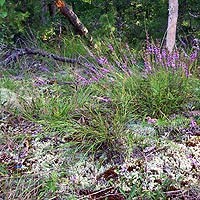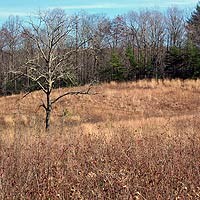
National Park Service The upland vegetation zone is characterized by fairly gentle topography, meaning the slopes are more gradual. Soils tend to be sandy, well-drained, and not particularly fertile. Many of the plants in this zone are tolerant of drier conditions. Although much of the upland zone appears to be somewhat uniform, there are subtle differences in its forest types. Several unique plant communities also occur within this upland forest zone. Upland Forests Mixed-oak forests Mixed-oak forest is the dominant forest type in the park, particularly on broad ridges and middle to upper slopes. Although most common in the Upland Zone, mixed-oak forests also occur on upper sunny slopes of the Gorge Zone. Dry to moist variants of this forest type occur, depending on the topographic position, slope direction, and soil type. For example, on dry narrow ridges with thinner soil, the mixed-oak forest will include more species that are tolerant of poor dry soils. In contrast, shady, east-facing, middle slopes with deeper soil will be able to support a mixed-oak forest that includes more species that require rich, moist soil. Common trees that occur in the mixed-oak forest include white oak, chestnut oak, black oak, scarlet oak, southern red oak, red maple, pignut hickory, mockernut hickory, dogwood, blackgum, sourwood, sassafrass, serviceberry, and mountain stewartia. Common shrubs and vines include blueberries, huckleberries, mountain laurel, grapes, and greenbriers. In recent years, fire has been excluded from this forest type throughout much of the park, resulting in colonization by fire intolerant species, such as white pine, hemlock, and magnolias. American chestnut was formerly a common tree and can still be seen where sprouts grow from old root stocks. Allegheny chinkapin, a close relative to American chestnut, also commonly grows within this forest type, in certain sections of the park. 
NPS Dry oak-pine forests Dry oak-pine forests are commonly found growing in the Upland Zone, particularly on thin, dry soil on narrow ridges, near cliff edges, and on sunny, upper, south-facing slopes. Where soil is more developed and capable of holding more moisture, hardwood trees may be more abundant than pines. The opposite is true where soil is extremely thin; pine trees dominate in these conditions. Thin bands of pine-dominated forest were recently common along bluffs edges, on sandstone points, and on narrow ridges; however, many of these pine trees were killed in the years 1998-2002 by the southern pine beetle, a native forest insect. Thick patches of mountain laurel with scattered red maple, sourwood, blackgum, chestnut oak, post oak, and serviceberry are often all that remains since the pine beetle infestation. In hardwood-dominated variants of the oak-pine forest, scarlet oak, black oak, chestnut oak, post oak, sourwood, blackgum, red maple, and sand hickory are common. Mountain laurel, blueberries, huckleberries, witchhazel, and greenbriers are common shrubs and vines. In addition to thin, dry soil, fire may play a role in the occurrence and maintenance of these forest types. The absence of fire in recent years may account for an increased abundance of red maple throughout the park’s oak-pine forests. Starting in 2005, the park began using prescribed fire to enhance and maintain this type of forest. Over time, Virginia and shortleaf pine will colonize these dry habitats and once again be a prominent component of the landscape. 
NPS Fields The park’s many old fields are evidence of former homesteads and agricultural fields that once dotted the landscape. Many former fields have been reclaimed by the forest and are now thickly covered with Virginia pine, yellow poplar, and sweetgum. Those fields that remain are often infested with non-native plants, such as tall fescue, sericea lespedeza, multiflora rose, and autumn olive. However, these open habitats are important for certain wildlife. Efforts are currently underway to manage these fields in a way that eliminates exotic species and encourages native grasses, forbs, and shrubs for the benefit of wildlife, for more information visit the Fields Management Plan. Restored fields will be dominated by plants such as little bluestem, big bluestem, Indiangrass, goldenrods, asters, milkweeds, blackberries, sumac, persimmon, and other important wildlife food and cover. Unique Upland Communities Sandstone Glades and Barrens Throughout the park’s uplands, exposed seams or knobs of sandstone provide habitat for a sparse but interesting mix of plant species. Woody plants include Virginia pine, farkleberry, serviceberry, and chokeberry. Herbaceous plants include little bluestem, oat grass, small-headed blazing star, Appalachian sandwort, golden-asters, stiff-leaved aster, and orange-grass. Fruticose lichens, often known as reindeer moss, are prominent on some sites. 
National Park Service Streamheads and Seeps Streamheads and seeps occur like lush oases in the middle of the otherwise dry upland landscape. Most of these habitats remain wet throughout the year, although some may dry during extreme or prolonged drought. They are host to a unique group of wetland plants that contrast sharply with the plants in the surrounding dry woodlands. Red maple and blackgum are the most common tree species. Alder, chokeberry, buttonbush and other wetland shrubs are common. Thick patches of cinnamon fern, netted chain fern, and royal fern often make it difficult to see one’s feet, which may be squishing over heavy mats of sphagnum moss. A number of rare plants are known to occur in this habitat. |
Last updated: April 14, 2015
